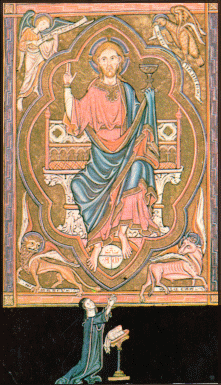
For some people, life in a monastery or nunnery did not bring them close enough to God. These people became hermits, living alone, often in wild or deserted places, in a cave or hut they had built. They ate only the food they could grow themselves or what they were given as gifts, and spent their days praying or thinking about God's ways.
Some hermits set up their home near a ford, a marshy swamp or a forest path so that they could act as a guide to travellers. Sometimes a nun, called an anchoress, would have herself shut in a tiny cell next to a church, with only a small window looking into the church.
Living alone and reflecting on God and the life of Jesus, hermits and anchoresses sometimes had visions. Mother Julian of Norwich was a famous anchoress born in the 14th Century. She saw a series of sixteen visions which she called 'showings', and wrote them down. In one, she saw Christ suffering on the cross with beads of bright red blood, dripping from his head beneath the crown of thorns so fast they looked like raindrops dripping from the eaves of a house. Although the visions were sometimes frightening, they were also comforting because they showed Christ's great love for people.

A nun sees a vision of Christ
Another well-known hermit was Godric of Finchale. He began as a peddlar, tramping the roads selling goods. He made enough money to be able to settle down and send others out peddling wares for him. He was soon a wealthy merchant, engaging in business, owning ships, travelling abroad. Yet he felt he was a man who had committed many sins, and gave up his home and his wealth to live as a hermit. He was made a saint after his death.

A wood-carving of a peddlar from Swafham in Norfolk
One order of monks, called Carthusians, lived as a group in one building, but tried to follow hermits' ways. Each monk slept in his own cell in a stone coffin (to remind him that his time on earth was short, and that it was the life after in Heaven that mattered). They were not allowed to speak to one another at all, except to say 'memento mori' ('remember death'). Carthusian churches are often very interesting. Some have a roof shaped like a coffin. As you enter the church an Angel of Death holding a scythe ready to cut off your life swings just above your head. It is the pendulum of a clock above the church door.